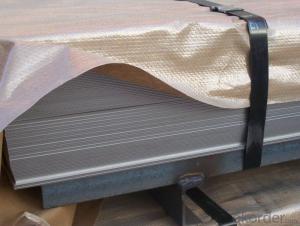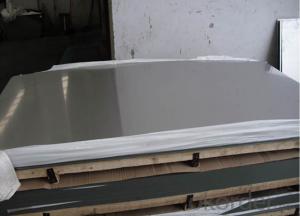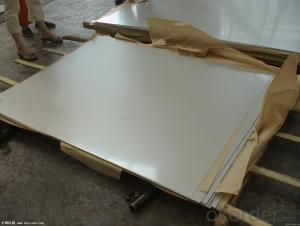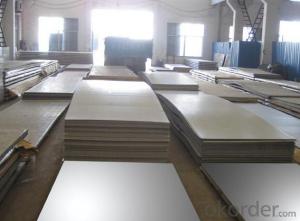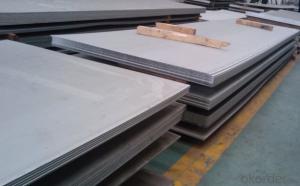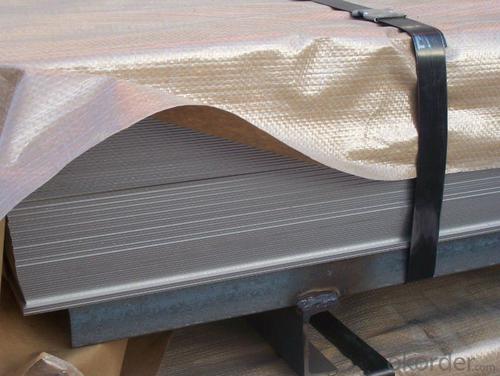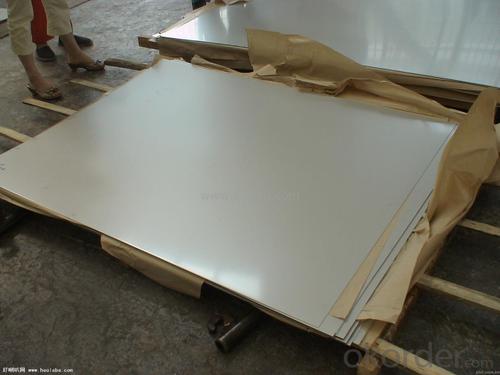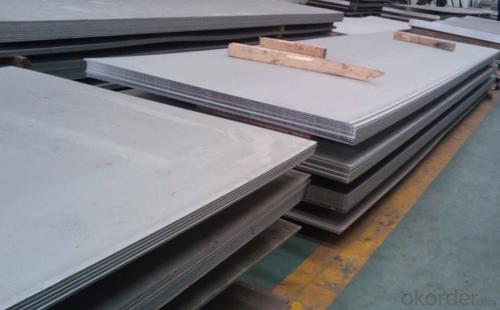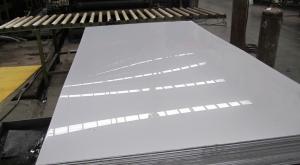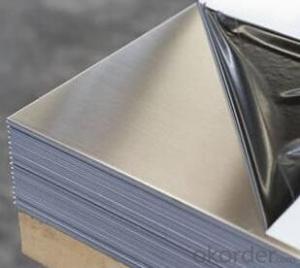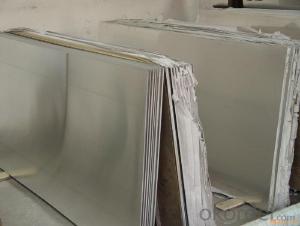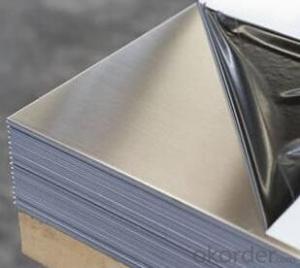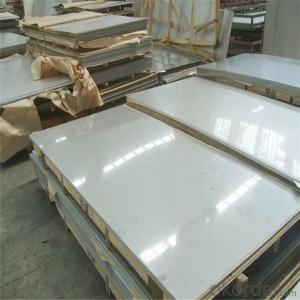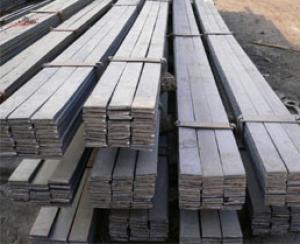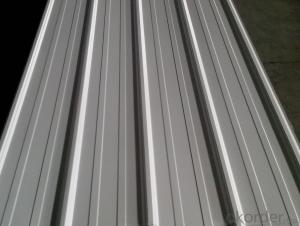Stainless Steel 316 sheet and plate for sales
- Loading Port:
- Shanghai
- Payment Terms:
- TT or LC
- Min Order Qty:
- 1000 m.t
- Supply Capability:
- 1000000 m.t/month
OKorder Service Pledge
OKorder Financial Service
You Might Also Like
Stainless Steel 316 sheet and plate for sales
Description of Stainless Steel 316 sheet and plate for sales:
Stainless steel is a production which not easy rust,acid resistance and corrosion resistance,so it is widelyused in light industry,heavy industry,daily necessities and the decoration industry.my company long-termsupply stainless steel porducts including:stainless steel sheet,stainless steel coil and stainless steel tube.
Main Features of Stainless Steel 316 sheet and plate for sales:
•Escalator, Elevator, Doors
•Furniture
•Production tools, Kitchen appliances, freezers, cold rooms
•Auto Parts
•Machinery and Packaging
•Equipment and Medical devices
•Transport system
Maintance of Stainless Steel 316 sheet and plate for sales:
(1) Regular cleaning and maintenance
(2) Pay attention to prevent the occurrence of the phenomenon of surface scratches
(3) Use soap, weak detergent or warm water to remove surface dust, dirt
(4) In addition to the surface of the binder with alcohol or an organic solvent (ether, benzene)
(5) Use neutral detergent or ammonia solution in addition to surface oil
(6) With 10% nitric acid or abrasive detergent in addition to the surface of the embroider caused by the dirt.
Applications of Stainless Steel 316 sheet and plate for sales:
Stainless steel’s resistance to corrosion and staining, low maintenance and familiar lustre make it an ideal material for many applications. There are over 150 grades of stainless steel, of which fifteen are most commonly used. The alloy is milled into coils, sheets, plates, bars, wire, and tubing to be used in cookware, cutlery, household hardware, surgical instruments, major appliances, industrial equipment Storage tanks and tankers used to transport orange juice and other food are often made of stainless steel, because of its corrosion resistance and antibacterial properties. This also influences its use in commercial kitchens and food processing plants, as it can be steamcleaned and sterilized and does not need paint or other surface finishes..
Specifications of Stainless Steel 316 sheet and plate for sales:
Description | steel sheet,hot rolled steel sheet,cold rolled steel sheet, steel sheet,sheet,steel plate |
Standard | ASME, ASTM, EN ,BS,GB,DIN, JIS etc |
Application | Steel sheet applies to construction field, ships building industry, petroleum & chemical industries, war and electricity industries, food processing and medical industry, boiler heat exchanger, machinery and hardware fields. |
Packaging | Standard export sea-worthy packing |
Delivery time | 10-30 days |
Quality | No.1 |
Productivity | 500 tons/Day |
Note | Our company has cooperative relation between the domestic agents. Stainless steel sheet can be made accordingto the customers requirements. Fasten delivery. Quality assured. |
Contacts | If you have any question,please feel free contact me. |
Surface Finish Characteristics of Stainless Steel 316 sheet and plate for sales:
| Surface finish | Characteristics and application |
| 2B | The surface brightness and flatness of no2B is better than no2D. then through a special surface treatment to improve its mechanical properties,No2B could nearly satisfy comprehensive uses. |
| No.1 | Polished with abrasive belt of grit#100-#200, have better brightness with discontinuous coarse stria, used as inner and external ornaments for building, electrical appliances and kitchen utensils etc. |
| No.4 | Polished with abrasive belt of grit #150-#180,have better brightness with discontinuous coarse stria, but thinner than No3, are used as bathtub buildings inner and external ornaments electrical appliances kitchen utensils and food processing equipment etc. |
| HL | Polished with abrasive belt of grit #150-#320 on the NO.4 finish and has continuous streaks, mainly used as buildings ornaments elevators, door of building, frontal plate etc. |
| BA | Cold rolled, bright annealed and skin-passed, the product have excellent brightness and good reflexivity like mirror, kitchen apparatus, ornament etc. |
| 8K | The product have excellent brightness and prefer reflexivity can to be the mirror. |
Images of Stainless Steel 316 sheet and plate for sales:
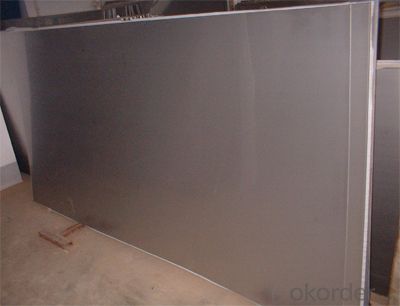
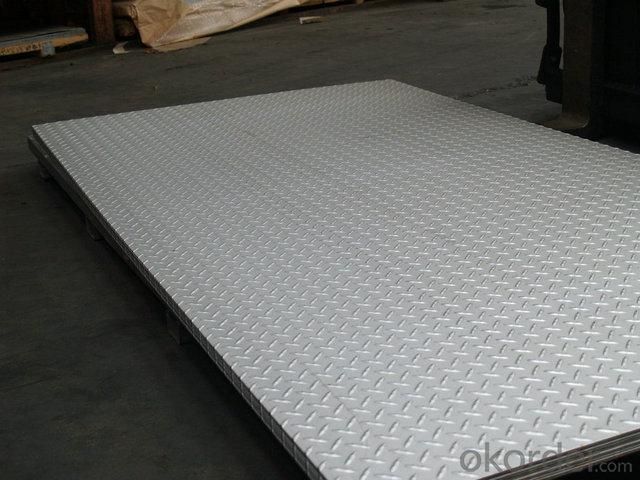

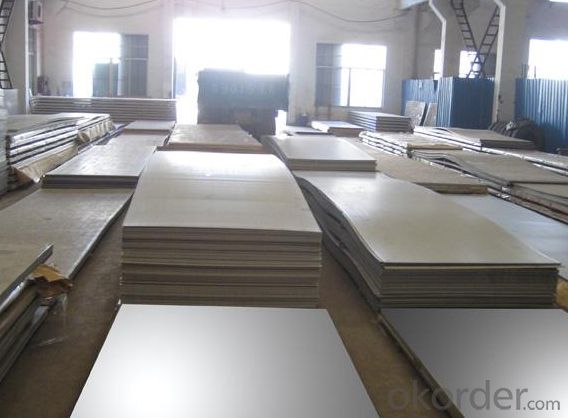

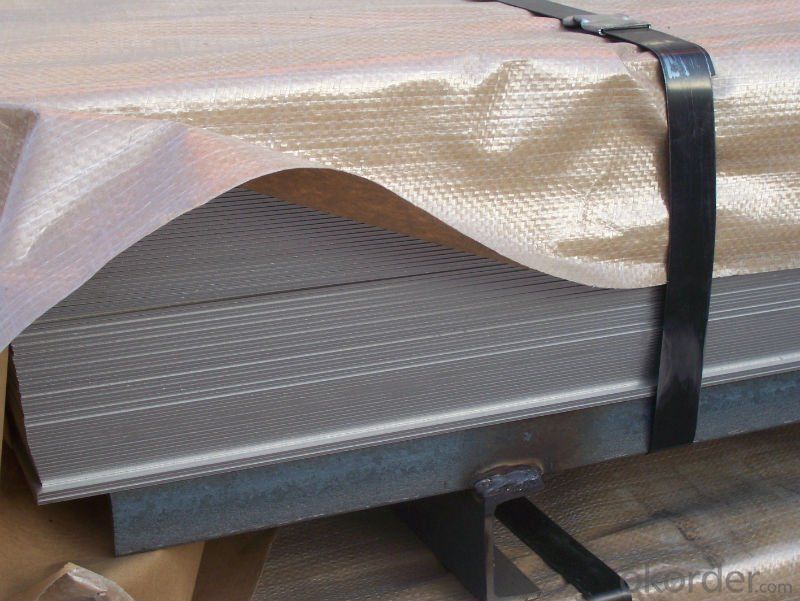
Sandard Seaworth Packing(wooden packing with water proof paper):
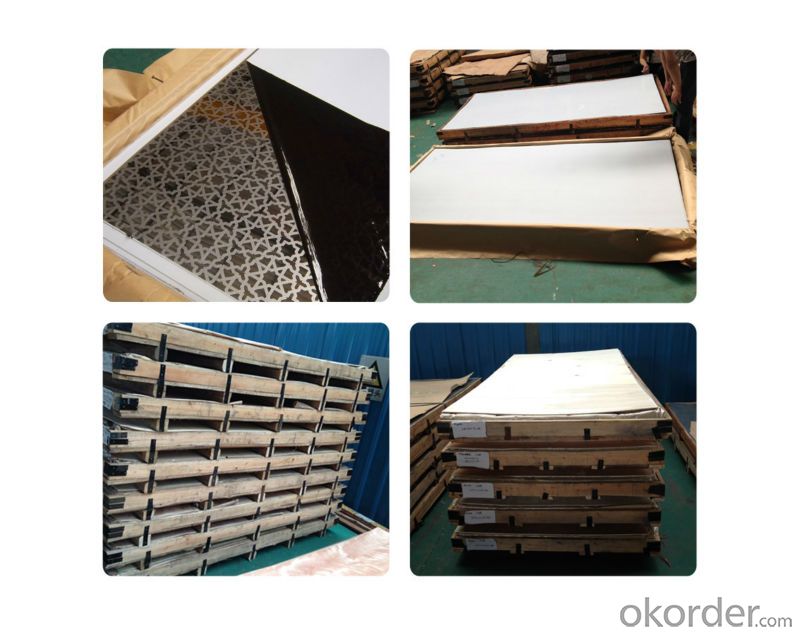
FAQ:
1. What are we supplying?
We are specialized in producing stainless steel coil, stainless steel (plate/sheet), and duplex stainless steel for a prelonged period. We are currently supplying grade of steel of 201/202,304/304L, 310S/309S/316L/316Ti/321, 410/420/430/443/444/409L, and 904L.
2. How Many years experience do we have?
We have been exported to more than 20 countries in the past 15 years.
3. How long do we usually reply your request?
We always reply our customer within 24 hours.
Our company adheres to the tenet of "survival by quality, build brand by reputation, win market by prices and innovate to develop", has developed international markets and the products are well sold in many countries as Singapore, Indonesia, South Korea, Dubai, Pakistan, Sri Lanka, Vietnam, Iran, Malaysia, Mexico, Chile, Brazil, Holland, Italy, Belgium, Russia, Moldova, Paraguay, Uruguay, Germany, Spain, USA etc. More than 40 countries.; commonly we have more than 500tons stainless steel materials in stock; so w can arrange the soonest delivery too; also we hope we will have chance to cooperate with your esteemed company!
- Q: What are the factors to consider when selecting the right grade of stainless steel sheet?
- When selecting the right grade of stainless steel sheet, there are several factors that should be considered. First and foremost, it is important to consider the intended application of the stainless steel sheet. Different grades of stainless steel have varying levels of corrosion resistance, strength, and temperature resistance. Therefore, understanding the specific requirements of the application, such as exposure to corrosive environments or high temperatures, is crucial in selecting the appropriate grade. The next factor to consider is the desired appearance and finish of the stainless steel sheet. Some grades of stainless steel are more suitable for achieving a highly polished or mirror-like finish, while others are better suited for a brushed or matte appearance. Additionally, certain grades may be more resistant to scratching or showing fingerprints, which can be important in applications where aesthetics are a priority. Cost is another important factor to consider when selecting the right grade of stainless steel sheet. Different grades of stainless steel can vary significantly in price, depending on factors such as the alloying elements used, manufacturing process, and availability. It is important to balance the desired properties and performance of the stainless steel sheet with the available budget. The ease of fabrication and welding is also a critical factor to consider. Some grades of stainless steel are more easily machinable and formable than others, making them better suited for certain fabrication processes. Similarly, certain grades have better weldability, which can be important in applications where welding is required. Lastly, it is important to consider the availability and sourcing of the selected grade. Some grades of stainless steel may be more readily available in certain regions or from specific suppliers. It is important to ensure that the selected grade can be easily sourced to avoid delays or increased costs in the supply chain. In conclusion, when selecting the right grade of stainless steel sheet, factors such as the intended application, desired appearance, cost, ease of fabrication and welding, and availability should all be carefully considered. By evaluating these factors, one can make an informed decision and select the most appropriate grade of stainless steel sheet for their specific requirements.
- Q: How to calculate the weight of stainless steel plate?
- Stainless steel not only refers to a stainless steel, but more than one hundred kinds of industrial stainless steel, the development of each kind of stainless steel in its specific application areas have good performance. The key to success is to find out what the purpose is, and then determine the correct type of steel.
- Q: What are the different surface patterns available for stainless steel sheets?
- There are several different surface patterns available for stainless steel sheets, each offering unique aesthetic appeal and functional properties. One popular option is the brushed finish, which is achieved by brushing the surface of the stainless steel sheet with a fine abrasive material. This creates a visually appealing pattern of parallel lines, giving the sheet a sophisticated and elegant look. The brushed finish also helps to hide scratches and fingerprints, making it a practical choice for applications where appearance is important. Another common surface pattern is the mirror finish, which is achieved by polishing the stainless steel sheet to a highly reflective and glossy surface. This finish is often used in architectural and decorative applications where a sleek and luxurious appearance is desired. The mirror finish also has the advantage of being easy to clean and maintain. Embossed or textured patterns are also available for stainless steel sheets. These patterns are created by stamping or rolling the sheet with a specific design, resulting in raised or recessed areas on the surface. This not only adds visual interest to the sheet but also enhances its grip and resistance to slipping, making it suitable for applications such as flooring or industrial equipment. Additionally, there are perforated stainless steel sheets that feature a pattern of small holes or slots. These sheets are commonly used for architectural purposes, such as decorative screens or facades, as well as for filtration or ventilation applications. The perforations can be made in various shapes and sizes, allowing for customization based on specific requirements. Overall, the choice of surface pattern for stainless steel sheets depends on the desired appearance, functionality, and application. Whether it's the sleek and refined brushed or mirror finish, the textured and resilient embossed patterns, or the versatile perforated sheets, there is a wide range of options available to suit different needs.
- Q: What are the different edge finishes available for stainless steel sheets?
- For stainless steel sheets, there are multiple edge finishes available, each with its own distinct characteristics and applications. 1. The mill edge is the original edge produced during the rolling process at the mill. It has a slightly rough appearance and may contain mill scale or imperfections. This edge is suitable for industrial or structural use, where aesthetics are not a primary concern. 2. The sheared edge is obtained by cutting or shearing the stainless steel sheet to size. It has a clean-cut, straight appearance and is commonly used in applications where a smooth edge is desired, such as architectural or decorative purposes. 3. After the shearing process, the edges of the stainless steel sheet can be deburred to remove any sharp or rough edges. This creates a smooth and safe edge, making it suitable for applications where safety is a concern, such as food processing or medical equipment. 4. The rolled edge is achieved by rolling the stainless steel sheet, resulting in a rounded or curved edge. This edge finish is often used in applications where safety is important, as it eliminates sharp corners and edges, reducing the risk of injury. 5. A beveled edge is created by cutting or grinding an angle onto the edge of the stainless steel sheet. This edge finish is commonly used in architectural or decorative applications, as it provides a stylish and visually appealing appearance. 6. The polished edge involves polishing the edge of the stainless steel sheet to create a smooth and reflective surface. Polished edges are often used in high-end architectural or decorative applications, as they enhance the overall aesthetic appeal of the stainless steel sheet. When choosing the appropriate edge finish for your application, it is essential to consider factors such as aesthetics, functionality, and safety.
- Q: How do you straighten bent stainless steel sheets?
- To straighten bent stainless steel sheets, there are a few methods you can try depending on the severity of the bend. 1. Cold straightening: For slight bends, you can use a rubber mallet or a hammer to gently tap the bent area back into place. Start from the center of the bend and work your way towards the edges, applying gradual and even pressure. Be careful not to hit the stainless steel too hard, as it may cause further damage. 2. Heat straightening: If the bend is more severe, you can use heat to soften the stainless steel, making it easier to straighten. Start by heating the bent area using a blow torch or a heat gun. Once the stainless steel becomes red-hot, use pliers or a vice grip to carefully straighten the sheet. Keep in mind that this method should only be used for thicker stainless steel sheets, as thinner ones may warp or lose their shape if exposed to excessive heat. 3. Mechanical straightening: This method involves using specialized tools like a hydraulic press or a metal brake to apply controlled pressure and straighten the bent stainless steel sheet. This is recommended for large or heavy-duty sheets that cannot be easily straightened by hand. Ensure that you follow the manufacturer's instructions when using these tools to avoid any accidents. Remember to always wear appropriate safety gear, such as gloves and eye protection, when working with stainless steel sheets. If you are unsure or uncomfortable with straightening the sheets yourself, it is recommended to consult a professional metalworker or a fabrication shop for assistance.
- Q: Can stainless steel sheets be used for exterior cladding?
- Yes, stainless steel sheets can be used for exterior cladding. Stainless steel is highly resistant to corrosion, making it suitable for outdoor applications. It is durable, long-lasting, and provides an attractive aesthetic for building exteriors.
- Q: How are stainless steel sheets manufactured?
- Stainless steel sheets are typically manufactured through a process called hot rolling. First, raw stainless steel blocks are heated in a furnace until they reach a specific temperature. Then, they are passed through a series of rollers that apply pressure to the blocks, gradually reducing their thickness. This process elongates the metal and creates sheets of stainless steel with the desired dimensions. After hot rolling, the sheets undergo annealing, a heat treatment process that enhances their strength and corrosion resistance. Finally, the sheets are cut into the desired size and undergo further processing, such as surface finishing or coating, depending on their intended use.
- Q: Can stainless steel sheets be used in food processing industry?
- Indeed, the food processing industry can utilize stainless steel sheets. This industry favors stainless steel due to its corrosion resistance, ease of cleaning, and non-reactivity with food and beverages. Moreover, its strength and durability render it appropriate for a range of purposes such as food preparation surfaces, storage containers, and equipment. Furthermore, stainless steel sheets possess a smooth and non-porous surface, effectively impeding bacterial growth and ensuring food safety. In summary, stainless steel sheets prove to be a dependable and hygienic option for implementation in the food processing industry.
- Q: How do you prevent scratches or dents on stainless steel sheets?
- There are several measures that can be taken to avoid scratches or dents on stainless steel sheets: 1. Exercise caution when handling: Take care not to drop or drag stainless steel sheets against rough surfaces. It is advisable to wear gloves or protective gear to minimize the risk of scratches caused by sharp objects or tools. 2. Opt for gentle cleaning materials: To prevent scratches when cleaning, use soft cloths or non-abrasive sponges. Avoid steel wool or harsh cleaning agents that can harm the surface. Also, make sure to wipe in the direction of the grain to preserve the stainless steel's appearance. 3. Apply protective films or sheets: Adding a protective film or sheet to the stainless steel surface can provide an extra layer of defense against scratches or dents. These films are typically adhesive and can be easily removed once the stainless steel sheets are installed. 4. Store correctly: Store stainless steel sheets in a clean and dry environment to prevent scratches or dents caused by contact with other objects. Avoid stacking sheets directly on top of each other without any protective barrier in between. 5. Invest in edge protectors: Stainless steel sheets are often susceptible to dents or scratches on their edges. Using edge protectors or corner guards can help prevent damage during handling, transportation, or storage. By adhering to these preventive measures, the likelihood of scratches or dents on stainless steel sheets can be significantly reduced. This will ensure their durability and preserve their flawless appearance.
- Q: What are the different types of mirror finishes available for stainless steel sheets?
- There are several types of mirror finishes available for stainless steel sheets, including #8 mirror, 2B mirror, and 4 mirror.
Send your message to us
Stainless Steel 316 sheet and plate for sales
- Loading Port:
- Shanghai
- Payment Terms:
- TT or LC
- Min Order Qty:
- 1000 m.t
- Supply Capability:
- 1000000 m.t/month
OKorder Service Pledge
OKorder Financial Service
Similar products
Hot products
Hot Searches
Related keywords
